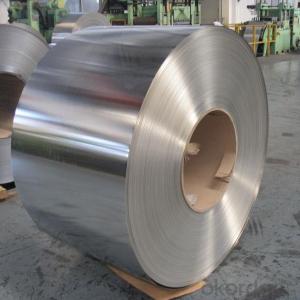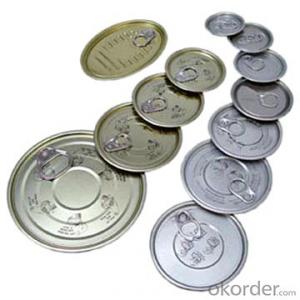Best Quality Easy Open End, Tinplate And Aluminum Material
- Loading Port:
- Guangzhou
- Payment Terms:
- TT OR LC
- Min Order Qty:
- 1000000 pc
- Supply Capability:
- 10000000 pc/month
OKorder Service Pledge
OKorder Financial Service
You Might Also Like
Brief Details
tuna fish can
1.Tinplate 401#
2.Dia:98.9mm
3.Full open
Specifications
Name | tuna fish can |
Item No. | 401# |
Shape/type | Round |
Size(mm) | Dia 98.9 |
Coating | White porcelain |
Material | Tinplate |
Pcs/20 GP’ | 950,000 Customize packing: as clients’ requests. |
Features | 1.Used for packaging of tomato paste,jam,salad…etc. 2.Have illustration printing on the lid. 3.Coating can be according to the customer required. |
Our Workshop


FAQ
1.Q: What is the material of EOE?
We can offer both tinplate and aluminum material made EOE;
2.Q:Could you offer samples for our testing?
YES, we could offer sampler for free if needed;
3. Q:Can you make new mold with customized size I need?
YES, We can make mold for you if reach some qty.
- Q: Why do tin tins rust easily when they are opened?
- It turned out to be sealed and oxygen has been transpiring. When opening is oxidized (Fe2o3), there is rust.
- Q: How does tinplate contribute to the overall versatility of packaging?
- Tinplate contributes to the overall versatility of packaging by offering numerous benefits such as exceptional strength, corrosion resistance, and excellent formability. Its ability to withstand extreme temperatures and protect products from moisture and oxygen makes it suitable for a wide range of packaging applications. Additionally, tinplate's versatility extends to its ability to be easily shaped, printed, and decorated, allowing for attractive and customized packaging designs.
- Q: How does tinplate compare to plastic in terms of durability?
- Tinplate generally offers better durability compared to plastic. It is a sturdy material that can withstand external pressures and resist dents or breakage. Additionally, tinplate is less prone to cracking or warping over time, offering a longer lifespan for products made from it. On the other hand, plastic can be more prone to scratches, cracks, and degradation over time, making it less durable than tinplate.
- Q: Soup with tin cans loaded also need high temperature sterilization?
- If you are a start-up factory, you need to save money, you can choose a small sterilization pot, covering an area of small, heat source is also very good solution.
- Q: Tinned iron and iron matte tin in difference
- Tin tin in tin and iron is ordinary, the price is cheaper than the frosted iron, no sand surface, at the grassroots level printed on a white layer after printing all kinds of exquisite patterns, but also can do all kinds of gold silver transparent iron printing, in the light can return the light, give a person a kind of dazzling feeling also, high-grade, affordable prices, so the tinned iron printing packing made by wide customers.
- Q: How is tinplate used in the beverage industry?
- Tinplate is commonly used in the beverage industry for packaging purposes, such as cans for carbonated drinks, fruit juices, and other beverages. The tin coating on the steel sheet provides a protective barrier, preventing corrosion and maintaining the quality and taste of the beverage. Additionally, the versatility of tinplate allows for various shapes and sizes of cans, making it a popular choice for beverage manufacturers.
- Q: How does tinplate contribute to sustainable packaging?
- Tinplate contributes to sustainable packaging as it is 100% recyclable and can be reused indefinitely without losing its properties. It also provides excellent barrier properties, protecting the contents from light, oxygen, and moisture, thus extending the shelf life of the packaged products. Additionally, tinplate is lightweight, reducing transportation costs and emissions.
- Q: How does tinplate perform in terms of tamper resistance?
- Tinplate performs well in terms of tamper resistance due to its strong and durable nature. It is difficult to manipulate or tamper with, providing a secure packaging solution for various products.
- Q: What is the recycling process for tinplate?
- The recycling process for tinplate typically involves several steps. First, the tinplate is collected and sorted at recycling centers or facilities. It is then shredded into small pieces, allowing for easier processing. The shredded tinplate is then subjected to a magnet, which separates the tin-coated steel from any non-ferrous materials. The separated tinplate is melted down in a furnace, and impurities are removed through various processes. The molten tinplate is then cast into ingots or rolled into sheets, which can be used to manufacture new tinplate products. This recycling process helps conserve resources, reduce waste, and minimize the environmental impact of tinplate production.
- Q: What are the common printing and decoration techniques for tinplate?
- Some common printing and decoration techniques for tinplate include lithography, offset printing, embossing, debossing, hot stamping, and varnishing. These techniques allow for vibrant and detailed designs to be applied to tinplate surfaces, making them visually appealing and customizable for various products and purposes.
Send your message to us
Best Quality Easy Open End, Tinplate And Aluminum Material
- Loading Port:
- Guangzhou
- Payment Terms:
- TT OR LC
- Min Order Qty:
- 1000000 pc
- Supply Capability:
- 10000000 pc/month
OKorder Service Pledge
OKorder Financial Service
Similar products
Hot products
Hot Searches
Related keywords



























